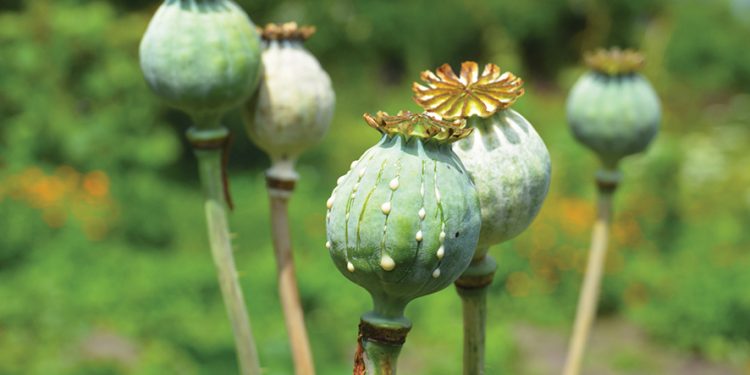What are the most recent changes on the EU opioids markets? What are the global geopolitical changes that impact supply? Do heroin trafficking routes change? How dangerous are synthetic opioids to Europe? This is one of the topics explored in a recent analysis — EU Drug Market – Heroin and Other Opioids — released by the EU Drug Agency (EMCDDA).
The analysis describes the European heroin market (the most commonly used illicit opioid), from its production and trafficking to its distribution and use. The analysis also details the criminal actors, processes and materials involved at various stages and levels of market. The data on heroin is supplemented, where available, by information about other opioids that are consumed and trafficked in the EU.
The EU heroin retail market is estimated to be worth EUR 5.2 billion per year. The amount of heroin seized in 2021 by EU Member States increased to 9.5 tonnes, the highest in 20 years. Large individual consignments were detected at seaports. Illicit opioid use is a major concern for the EU. It was responsible for approximately three-quarters (or 6 000) of the drug-related deaths in 2021. Around 1 million opioid users at high risk live in the EU.
Trafficking and distribution heroin is a mainstay activity of some criminal networks in the EU. These networks rely on a well-established infrastructure and contacts. Like with other drug types the heroin market is largely driven by the abuse of legal business structure, money laundering, and corruption.
The decline in Afghan opium production and cultivation: implications for Europe
In April 2022, the Taliban banned opium poppy production and cultivation in Afghanistan. The latest UNODC figures from 2023 show that both illicit opium production and cultivation in Afghanistan have declined by 95%. In 2023, Afghanistan’s cultivation was estimated at 10,800 ha (compared to 233,000 ha in 2022), and the opium production was estimated at 333 tons (6200 tons in 2022).
There are currently no signs of a heroin shortage in Europe. The report states that “the Taliban’s ban of opium cultivation could have an impact on heroin availability in Europe if it is sustained.” It will take some time before the effects of the events in Afghanistan are felt in Europe, but a decrease in heroin supply could lead to the market being filled with stimulants or synthetic opioids (e.g. Methamphetamine and cathinones have significant negative effects on the public health and security.
Traffickers change routes to exploit new opportunities and minimize risks
Four main routes are used to transport heroin from Afghanistan into Europe: Balkans, Southern, Caucasus, and Northern. The analysis describes the ways in which traffickers adjust routes and methods in order to minimize risks and take advantage of new opportunities.
The Balkan route is still a major corridor for heroin trafficking to the EU. However, seizures appear to be declining along this route due to perceived or actual tighter border controls on the overland section between Turkiye, Bulgaria and Turkey. The southern route into the EU appears to be a more popular route for heroin trafficking. The large quantities of heroin leaving ports in Iran and Pakistan as well as the significant seizures in European ports are evidence of this. The northern and Caucasus routes are still used, but the Russian war against Ukraine is likely to have contributed to a change in trafficking patterns. Some criminal networks are now looking for alternative routes. The United Arab Emirates (UAE), a major transhipment hub, is being used to conceal the nature and origin of heroin shipments. It is a major hub for money laundering, criminal coordination and drug trafficking.
The opioid market is complex and constantly evolving
The European opioid market has become increasingly complex. It includes diverted medicines, internationally controlled or highly potent synthetic opioids. Data on health effects (e.g., drug-related deaths, hospital emergencies) have shown that methadone, buprenorphine and its derivatives, fentanyl, and new synthetic opioids are more visible. Drug-related deaths and hospital emergencies. In the last five years, the majority of newly identified opioid substances that were reported to the EU Early Warning System about new psychoactive substances were highly potent benzimidazole opioids (nitazene), rather than fentanyl-derived opioids as they had been in previous years.
Comparatively, the EU was affected by synthetic opioids to a lesser extent than North America. This can be attributed in part to factors like strict prescribing, social healthcare provisions, and the development of treatment and harm reduction programs for existing opioid users. These substances are still a major problem in some EU countries, especially the Nordic and Baltic countries. The analysis calls for increased preparedness throughout the EU.
Addressing current threats, and boosting resilience
The report draws on data and information from Europol’s information on serious and organized crime and the EMCDDA drug monitoring system. The agencies use a threat assessment to highlight key areas of action at EU and member state level to respond to the developments on the illegal heroin and opioids market. These include improving the strategic picture of intelligence, strengthening responses to decrease supply and enhance safety, boosting international collaboration, investing in capacity building, strengthening policy, public and safety responses.
Alexis Goosdeel, Director of the EMCDDA, says: “Europe’s opioid problem is evolving rapidly and becoming more complex. It’s shaped by global changes that could have far-reaching consequences for our preparedness. We must strengthen our ability to detect and counter the health and security risks that are emerging from a changing market for opioids. Keeping and developing a portfolio of integrated and evidence-based health and social responses, is more important now than ever. In order to achieve this, we must build on the lessons and results learned over the past 30 years in European drug policy. We need to be guided by the fundamental rights of all stakeholders and the active participation from people who use drugs. We must adapt our prevention, harm reduction and treatment offer as substance use patterns and consumption patterns change and become more complicated.
Catherine De Bolle, Europol’s Executive director, stated: “Although the cultivation of opium poppies in Afghanistan is declining, a close monitoring of the supply chains and the diversification market are paramount, as criminal organizations are known to always be on the lookout of new opportunities.” Europol is committed to fostering intelligence-sharing, operational coordination, and international cooperation with partners in the fight to combat this worrying threat posed to Europe.
Read More @ georgiatoday.ge




